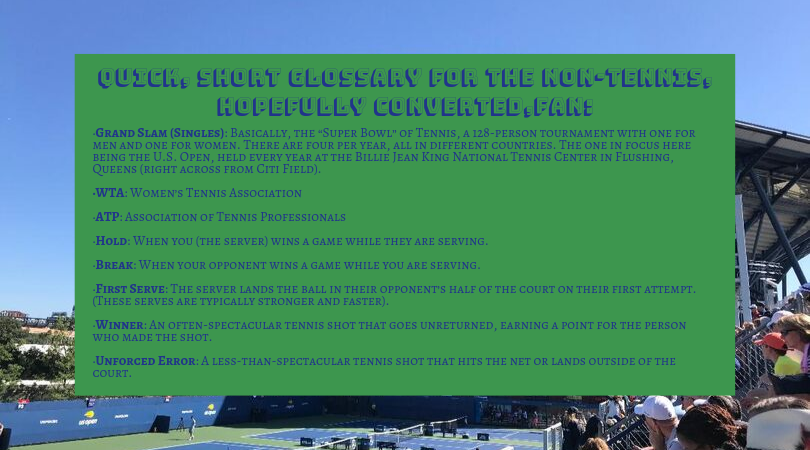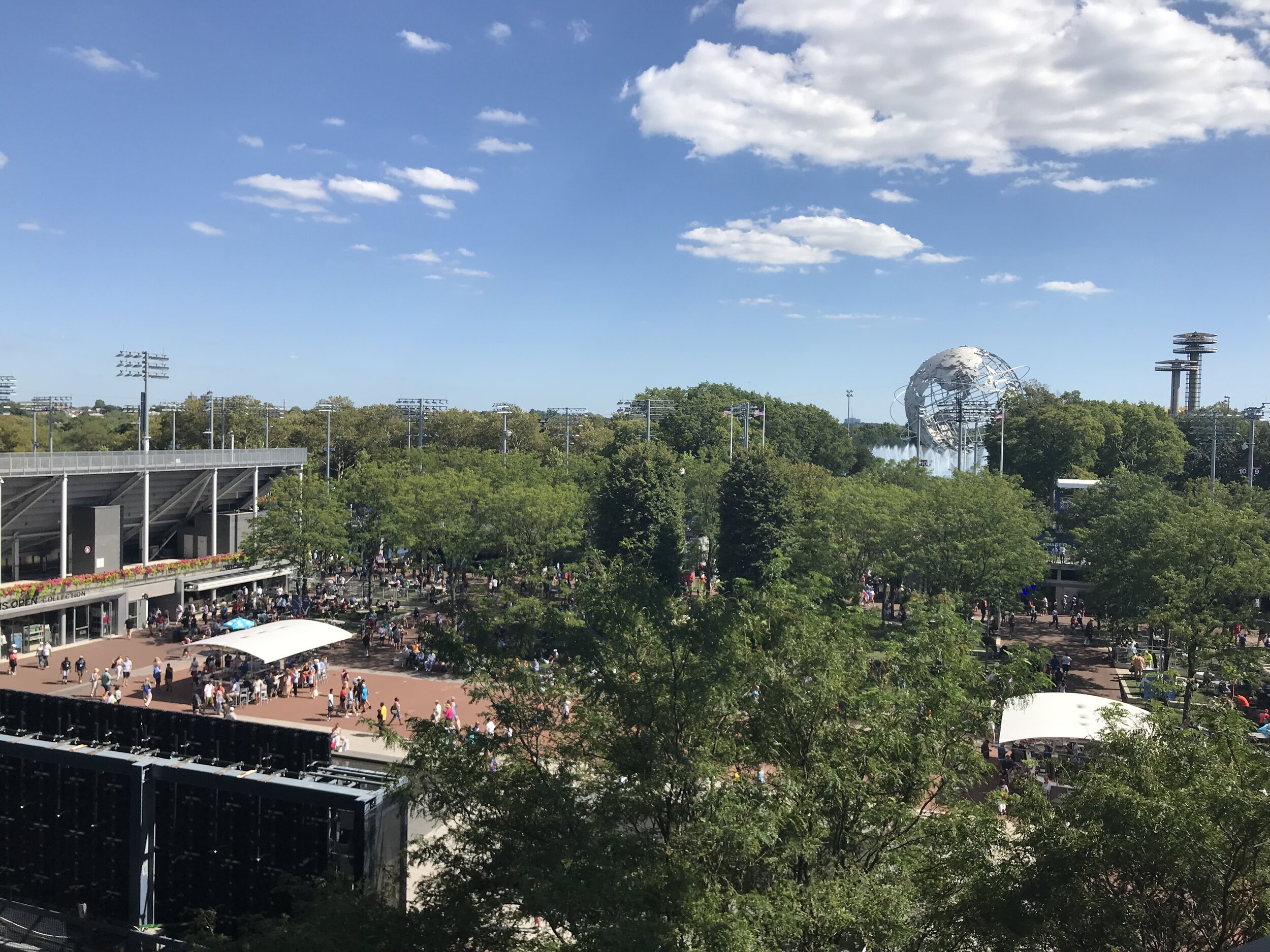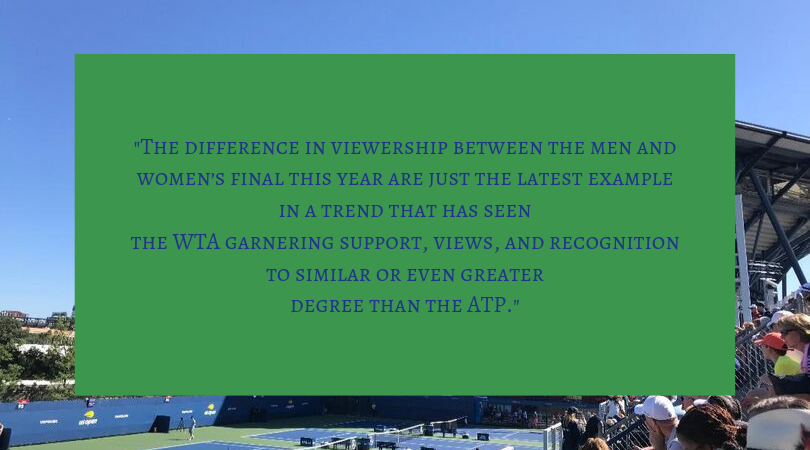U.S. Open 2019: The Numbers, The Moments, The Memories
Words and Photos by Matthew Romano
Graphics by Aspasia Celia Tsampas
Quick, short glossary for the non-tennis, hopefully-soon-converted, fan:
- Grand Slam (Singles): Basically,the “Super Bowl” of Tennis, a 128-person tournament with one for men and onefor women. There are four per year, all in different countries. The one infocus here being the U.S. Open, held every year at the Billie Jean KingNational Tennis Center in Flushing, Queens (right across from Citi Field).
- WTA: Women’s Tennis Association
- ATP: Association of Tennis Professionals
- Hold: When you (the server) wins a gamewhile they are serving.
- Break: When your opponent wins a gamewhile you are serving.
- First Serve: The server lands the ball intheir opponent’s half of the court on their first attempt. (These serves aretypically stronger and faster).
- Winner: An often-spectacular tennis shotthat goes unreturned, earning a point for the person who made the shot.
- Unforced Error: A less-than-spectaculartennis shot that hits the net or lands outside of the court.
Consider this, everyone knows who won the Super Bowl each year even if you have never seen a game of football a day in your life, it’s almost like it’s the “American” thing to do. For some context, 3.2 million viewers tuned into the U.S. Open Women’s final this year, 2.7 million for the U.S. Open Men’s Final, and the average viewership for the entire two-week tournament was roughly 1.3 million. By comparison, Superbowl LIII, deemed by many to be one of the worst Super Bowls in league history, came in at a whopping 98.1 million viewers – making it the most-watched sporting event of the year, the U.S Open final’s barely making the top fifty. Luckily there are tennis-addicted fans who watch religiously, dish out hundreds on U.S. Open tickets as if it was a Beyoncé concert, and have the numbers and knowledge to show for it – filling in by the masses.

Wrapped in my towel and making a steady stream of water in my house on my stroll inside (knowing full well I’d hear about it from my parents later), I stop in the living room to check ESPN for baseball scores. What I find is a tennis match between American, Venus Williams (who I’ve obviously heard of before but don’t know much about) and Czech, Petra Kvitová. Normally I’d flip the channel, but something about Venus’ name – the play, the quickness of the shots, the constant excitement and payoff – kept my focus as I stood there, the stream of water becoming a puddle on the carpet, posting on Facebook about the match (because of course). It was September 5, 2017 (Yes, I swiped all the way down on my Facebook profile – can’t you stalk yourself on social media?). Now, more than two years later, I am writing this article inspired by finally making it to the U.S. Open, something that I’ve wanted to do since I watched Venus (Auntie V) win that match, in a soaked bathing suit, on a wet carpet, in a house of screams, eyes super-glued to the Wilson tennis ball darting across the court – the same court I visited two weeks ago a bigger fan than ever, watching Kvitová once again. Here are some of the numbers, the moments, and the memories from this year’s U.S. Open.

Women’s Final:
Bianca Andreescu (Can.) def. Serena Williams (U.S.): 6-3,7-5
Bianca Andreescu, only 19 years old, pulled off one of thebiggest upsets of the year in the biggest match of her career, defeating23-time Grand Slam winner, Serena Williams of the United States. The underdogcertainly won in this one – it was Andreescu’s maiden Grand Slam final andWilliams’ 33rd. Most recently, Serena made the finals at Wimbledon(losing to Romanian, Simona Halep) and has lost what is now the last 4 grandslam finals since her return to the WTA tour following the birth of herdaughter, Olympia, and a bout with post-partum depression (yes, it’s a realthing and yes, it can happen to anyone).
How It happened:
The Serena ‘slow-start’ lasted a bit too long for comfort inthis one. Williams would go down 1-5 in the second set (having lost the first3-6). Facing scoreboard pressure, in typical Serena fashion, she saved matchpoints as she clawed her way to 5-all in the second set. However, the comebackwas too little too late for the American who saw Bianca close out the match 7-5with a break and a hold of serve.
Some key stats illuminate Bianca’s dominance in this match:
- First Serve %: Bianca (66%) vs. Serena (44%)
- Winners to Unforced Errors: Bianca (19:17) vs.Serena (33:33)
The Exigence:
One may have expected the viewership and ratings for thisone to be slightly higher with Serena going for a rather elusive, record-tying,24th grand slam against rising Canadian star Bianca Andreescu.Serena, 38, is undoubtedly a major attention draw (on and off the courts –having launched her fashion line Serena with a show at NYFW), and herbeing an American certainly helped bring in the 3.2 million that watched. It isreasonable to assume that Andreescu’s Canadian roots also slightly contributedto higher American viewership. Despite American tennis’ seeming inability toreach past its base supporters – those being tennis fans, fans of individualplayers in the finals, and the many celebrities who often frequent the Open – thiswomen’s final ranks as the second-highest in terms of millions of viewers outof ESPN’s 256 U.S. Open telecasts.

Men’s Final:
Rafael Nadal (Esp.) def. Daniil Medvedev (Rus): 7-5, 6-3,5-7, 4-6, 6-4
In a grueling five setter, 19-time grand slam winner and four-timeU.S Open winner Rafael Nadal of Spain outlasted Russian-born 23-year-old andup-and-comer Daniil Medvedev in what was the former’s 27th grandslam singles final and the latter’s maiden one. In this one, the underdog fellshort to Nadal’s relentlessness and big-match experience.
How It happened:
Nadal broke first in what were gauntlet first and secondsets. Deadlocked on-serve the majority of those sets which both went Nadal’sway. In the next two must-win sets, Medvedev did just that with a net-game thatseemed to stymy his world-class opponent at times. The decisive fifth set wasall Nadal who withstood a late push by the Russian to clinch his 19thgrand slam title, second of the tennis season, and 4th at the Open.
The Exigence:
While there were no Americans in this men’s final to bring in crowds, and fans were ‘robbed’ of the much hoped-for Nadal vs. Federer clash, this match turned out to be one of the more electric matches of the entire tournament. With the win, the Spaniard climbed up the leaderboard to 19 grand slams, an earshot away from Swiss hero Roger Federer’s 20. Rafael is 33, Federer and Serena are 38 – and both are continuing to defy Father Time.

Other Important U.S. Open Moments
Coco-Mania!
What were you doing at 15 years old? Debating with yourfriends whether Takis or Flamin’ Hots were the superior spicy chip? Staring at #thedressmemes all day trying to prove to your friends that it’s Black and Blue? Well,at the age of 15, American tennis sensation Cori ‘Coco’ Gauff has modestlytaken the tennis world by storm with amazing, awe-inspiring performances againsttop players. I had the immense pleasure of going to the U.S. Open this year(best day of my life – hands down) and can say that the ‘mania’ is real. Thecrowds were raucous and deafening, the seats (and I mean every single one) werefilled, and the electricity was palpable.
The Rise of American Tennis and the WTA
Gauff is exemplary of an overall rise in quality, star power,diversity, and hype surrounding American Women’s tennis. Seeing as they are thetrailblazers, it is only natural to turn to the Williams sisters when thinkingof U.S. born tennis stars. However, stars such as Coco Gauff, 2017 U.S Openwinner Sloane Stephens (15), Madison Keys (13), veteran Alison Riske (32), aswell as new-wave American tennis sensations Amanda Anisimova (29) and SofiaKenin (17), round out the story and encapsulate the dominance of Americanwomen’s tennis. This all bodes well for a WTA that has risen in attentionconsiderably over the last few years.
The difference in viewership between the men and women’sfinal this year are just the latest example in a trend that has seen the WTA garneringsupport, views, and recognition to similar or even greater degree than the ATP.So, I end on this question: what other sport can say that their women’s leagueor division consistently incites the same or more media and mass excitement astheir male counterparts? Women’s soccer? Maybe. Women’s gymnastics? Certainly,but only in Olympic circles. What about the WNBA, the NCAAW – well theyunfortunately can’t hold a basketball to the almost suffocating hysteria andeminence of the NBA or NCAAB.
So, maybe tennis isn’t so bad after all. I mean, just look at the photos!






